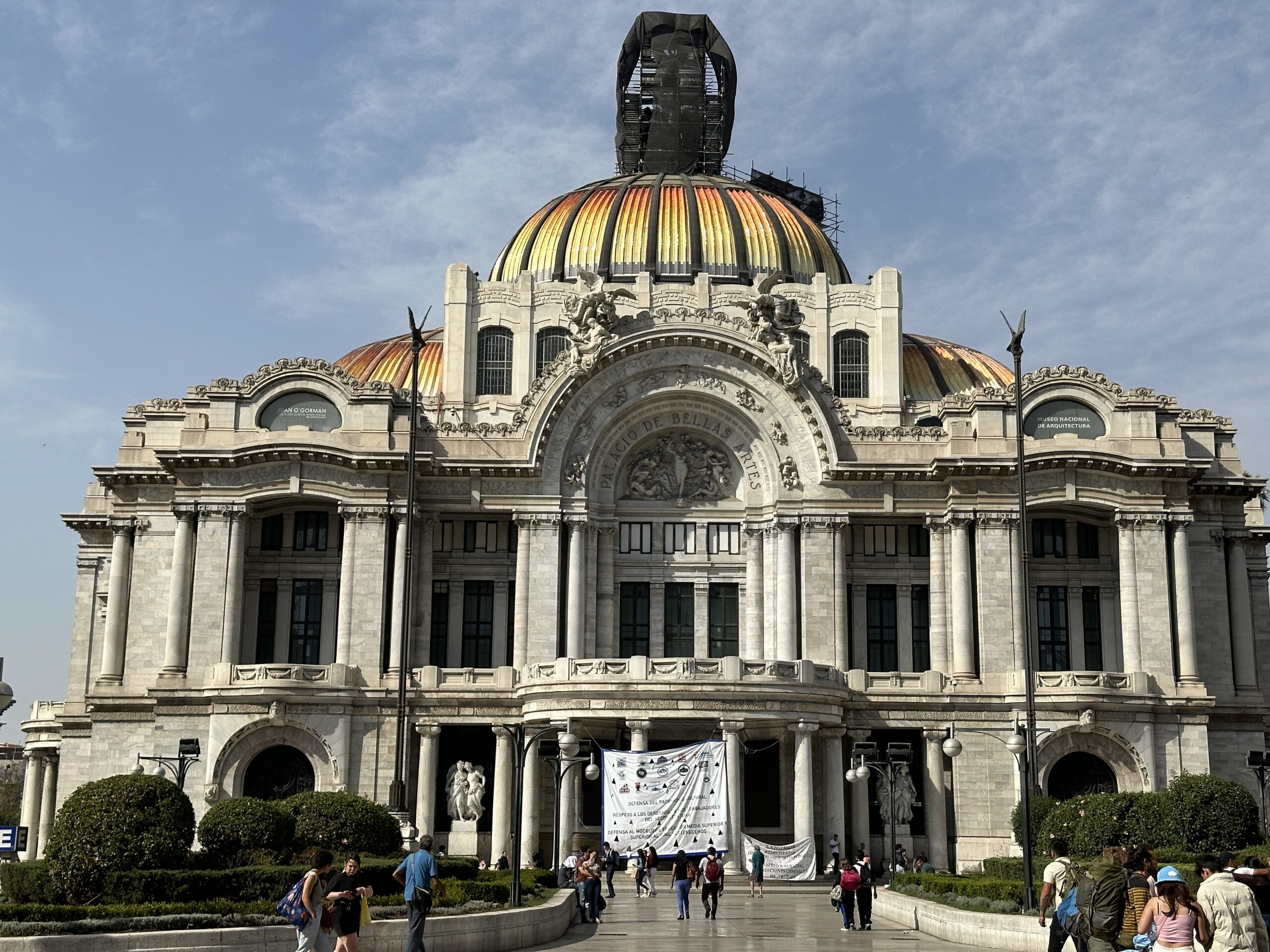Palacio de Bellas Artes

As I mentioned in the post on landing in Mexico City, the Museo del Palacio de Bellas Artes is a great hulking Oreo of a building, with a crunchy Art Nouveau exterior and creamy Art Deco insides. We can blame the Mexican Revolution for this cookie, as it halted construction of the Art Nouveau design until the 30s, when the interior was finished to the latest fashion.
Half of the Palacio is galleries and the other half is a performance space. There are a number of smaller galleries, which were closed when we there, and a single large gallery for rotating exhibits. The upper floor is a mural gallery, with massive pieces from Diego Rivera, José Clemente Orozco, and others.
Carnaval de la Vida Mexicana, Diego Rivera 1936
El Hombre Controlador del Universo, Diego Rivera, 1934
But the true star of the Palacio is the Palacio itself. The mixture of classic Art Deco with Mesoamerican motifs (a style I call AzDeco™, because of course I do) is a sight to behold. It might well exist elsewhere, but I wouldn’t be surprised if that particular mashup was unique to the Palacio.
Los Galerias
The galleries and lobby are where the Art Deco elements of the design are really permitted to fly their colors.
El Teatro
The theater, unlike the gallery space, is recognizably Art Nouveau. When construction was restarted in 1932, the new architect updated the rest of the interior design to Deco. However, the theater’s curtain suggests how it avoided that fate.

The “curtain” isn’t actually a curtain at all. It’s a 24 ton beast made of almost a million pieces of stained glass that was built by Tiffany in 1911. I strongly suspect that the dome and the proscenium arch were created at the same time as the curtain, and were likewise waiting for construction to restart.
But even if the curtain was the sum total of extant design components, there was no way to install that clearly Nouveau curtain and update the rest of the space to Deco. No matter what newfangled ideas the architect had, that theater was being built to the original 1910 design spec.


The proscenium arch appeared to be a mosaic, until the lights went down. It’s glass, and it glowed when the backlighting came on.
Ballet Folklórico de México
We were able to get interior shots of the theater because we saw the Ballet Folklórico de México perform there. There’s a lot to unpack about that performance. First, and most obvious, just beautiful. Great choreography, wonderful dancing, killer live music. The hall itself, which is structured like a small opera house (1,936 seats), has ridiculously good acoustics, even in the cheap seats, and showcased the live band perfectly. It’s probably the best sound I’ve ever heard in a hall that size.
But…
I thought the overall program had a problematic relationship with indigenous culture.
It opened with Los Matachines, a drum and dance performance specifically based on pre-Hispanic religious ceremonies from the northern region of Central Mexico. This video is from ten years ago, but it’s the same number, and was shot at the Palacio.
A rocking good way to start. Energetic, colorful, and crowd pleasing. But it wrote a check about representation that the rest of the program couldn’t cash. While it promised a program rich in Mexico’s varied cultures, that was one of only two performances rooted in indigenous traditions. The rest of the evening was myopically Hispanic.
Danza del Venado was the only other indigenous performance. It’s based on the traditional deer dance of the Mayo and Yaqui tribes of Sonora and Sinaloa.
And… that’s it. Maybe 10% of the entire program allocated to indigenous performances, which is an interesting take on Mexico’s cultural history. The nods to indigenous cultures almost made it worse. If it had been presented as Hispanic folkloric dance, instead of Mexican folkloric dance, it would have been at least understandable. Narrow-minded, but coherent. As it was, the pair of indigenous performances only served to highlight how very little the company seemed to care about the richest part of Mexico’s cultural heritage.
But there was one performance that, by itself, made the entire evening worthwhile, and it didn’t even involve dance. The live band did two solo songs, one of which was an example of son jarocho called simply Son Jarocho.
I knew nothing about son jarocho, and my mind was completely blown. I didn’t know that you could play a harp like it was a mandolin. It seemed almost like Mexican bluegrass, and why no bluegrass band has pulled in a son jarocho harp player is beyond me.
I think it sings to me because it has a lot in common with Cuban son. However, its roots are in Veracruz, with elements of indigenous music, West African music, and Spanish fandango. I could listen to it all day. Starting right now, I think.





















Love love love the deer dance!
All of the performances were wonderful. It’s just a really good company with a great repertoire. It was hard to enjoy it as it was happening with half of my brain, and have this overlay of, “Wait, WTF?” about the representation issue with the other half.
No one said art was easy.
So glad you got to hear this gorgeous Son Jarocho music! Reminding me to create a playlist now…so sparkling!
Please! That would be the perfect birthday present *hint*